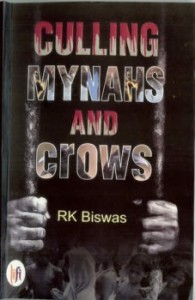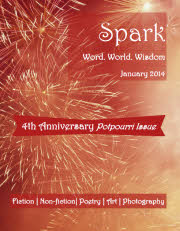by Vibha Sharma
Title : Culling Mynahs and Crows
Author : RK Biswas
Publisher :Lifi Publications
ISBN : 978-93-82536-19-2
The author’s note just in the beginning of the book mentions that ‘Culling Mynahs and Crows is set at a time when the city of Kolkata was known as Calcutta, which is why I have used the earlier name for the city.
Of the little that I have read of Bengali literature, I feel it stands out in one significant aspect – the stories’ strong women protagonists. The literary women characters may give an impression of being naïve, docile and dainty women initially but their fieriness comes to fore at the right time making a very strong impact in the story. Stalwarts like Rabindranath Tagore, Sarat Chander Chattopadhyay, Bibhutibhushan Bandyopadhyay or the recent ones like Jhumpa Lahiri, Chitra Banerjee Divakaruni, Suchitra Bhattacharya have all been able to master the art of pragmatically portraying the soul of a woman in their writings. Moreover, the contemporary writings are bringing out the changing urban milieu of our society. In ‘Culling Mynahs and Crows’, glimpses of the above mentioned significant traits do become visible – powerful women protagonists and subtle commentary on transitioning social makeup.
Culling Mynahs and Crows begins with journalist Agnirekha’s travel from Calcutta to Bisrampur on an assignment. The gossip about the assignment is that this is her senior’s way to settle scores with her by banishing her to a place where not much of any significant story could be found. Agnirekha is an upper class Bengali who is upset and now bitter because of how her career is taking shape. Almost a namesake to Agnirekha, Agnishikha is a breathtakingly beautiful small town girl hailing from Bisrampur. She nurtures simple dreams of settling down in marital bliss with her husband Sajal, who is a government officer in Calcutta. Sajal dreams to rise higher in hierarchy and the greed leads him to a path from where return is not possible. Ignorant of the ways of life in higher echelons, he ends up making his wife an alluring bait. He never gets the chance to set things right again albeit he loves his wife dearly ‘in flawed and cowardly way’. What follows is an action-filled sequence of events involving political goons and business honchos. The other side of the story involves crushed dreams, helplessness, frustration and fear. No matter what Agnishikha does or says, the vicious web around her keeps getting tougher to break. A maid and a mad woman turn out to be Agnishikha’s only friends, healers and allies.
Agnirekha and Agnishikha’s paths cross and the former’s reportage on latter’s life serves as a last nail in the coffin of Agnishikha’s desire to lead a normal life. In desperate need of some solace and peace she turns towards her pre-marital home but more tragedies are in store for her thereShe learns the hard way the price she needs to pay in order to survive. She transforms herself into a fire brand even as her inner self dies in the process.
Calcutta no longer remains a promising city for Agnirekha, and taking some small steps and some big strides, she eventually reaches Athens, Georgia through Bombay. It is in Athens, Georgia that she finally accepts and comes to terms with her sexuality, even as old heartaches are hard to heal. This explains her churlish behaviour all through as she struggled at two fronts – confronting her real identity and projecting an unreal one for the world.
Apparently, the author has tried to juxtapose the two protagonists – Agnirekha and Agnishikha, but as the narrative progresses, it feels Agnirekha’s character is getting a step-motherly treatment from the author.
A serial killer in Bisrampur happens to be among the ones who were introduced very early on in the story. A self-professed philanthropist, he lives his life on the premise – ‘What would you rather see mynahs and crows or bird of paradise?’ He extinguishes life in which the flame is already dead and this is his way of serving mankind. But it is interesting to notice that the philosophy of Paglakhooni (as he is popularly called) gets manifested in the story at various places.
The fast-paced narrative brings nail-biting, edge-of-the-seat thrill and the story becomes so engaging in the middle that it is un-putdownable. Besides offering a tight and interesting plot, Culling Mynahs and Crows subtly highlights the fast degenerating moral fabric of the society, bankruptcy of life values, vices like lust and greed dictating actions, declining ethics and dilemmas in human relations. The characters which are so painstakingly etched by the author come to life as the story progresses and there is a high chance that the readers will get emotionally invested in the story. However something feels amiss with the serial killer’s (Paglakhooni) character. In comparison with other characters in the story, the serial killer’s fades away. His character sketch deserves some more strokes to lend it a proper shape as does Agnirekha’s. Also, readers would wish to know how Agnishikha reached where she finally did. The author has taken a big risk in picking up similar sounding names of two prime characters and she has pulled it off successfully. Both the women actually live up to their names through their actions. RK Biswas deserves special appreciation for so thoughtfully picking up these two names.
Since the backdrop of the story is West Bengal of 1980s, it is interesting to see that period of time so vividly recreated in the narrative. The story has a strong feminist tone to it and that falls in line with the impression that I carry about Bengali literature or stories written by Bengali writers.
Culling Mynahs and Crows is RK Biswas’s first novel, but she is not a new name in literary circles. She has won many prizes and accolades for her short fiction and poetry earlier. She is one among the ten Indian poets to have been featured in an anthology edited by Jayant Mahapatra, published by Nirala Publications. She is a proud first prize winner in the Anam Cara Writer’s Retreat Short Story Competition 2012.
Vibha Sharma regularly reviews books in her blog http://literarysojourn.blogspot.com/







Thank you Vibha for your detailed and thoughtfully written review. 🙂
Moazzam, thank you for writing. And, I am looking forward to your own views too. You are an author yourself, with two story collections published – , one of which I have already read and loved – http://rumjhumkbiswas.wordpress.com/tag/the-idol-lover-and-other-stories/. 🙂
well written review, with good sense of the story. Some of us know Ms Biswas is a poet as well. It would’ve been nice to get a sense from the reviewer as to how language manifests itself as a character in the story. Or not.
No wonder her language is so lucid in prose as well. Each character is well thought out and is built gradually to a point where reader starts going through each emotion and experience along with the character.